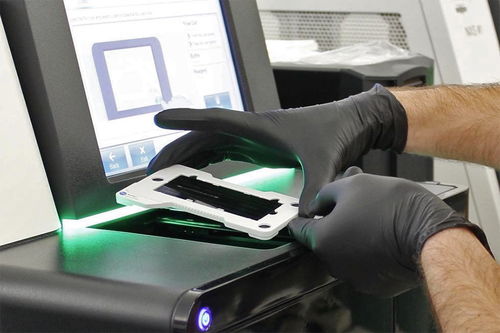
The University of Minnesota Genomics Center (UMGC) announced today it has received funding from the Centers for Disease Control and Prevention (CDC) to conduct genome sequencing on 6,000 COVID-19 samples to aid national and global viral surveillance efforts.
The nearly $750,000 contract will allow UMGC to sequence samples of SARS-CoV-2, the virus that causes COVID-19, over the course of one year in collaboration with the Minnesota Department of Health (MDH). Sequencing allows scientists to determine the exact nature of the virus at the genetic level, which known variant it pertains to and whether any new virus mutations are present.
“Sequencing and genomic surveillance have been, and will continue to be, really important throughout the pandemic,” said Daryl Gohl, Ph.D., principal investigator on the CDC contract and group leader with UMGC’s Innovation Lab. “Understanding when the virus is evolving and how it is changing lets you determine how outbreaks are happening and if additional public health interventions are needed.”
Public health experts can use the data and analysis provided through sequencing to trace where virus outbreaks originate, monitor for new variants, and spot changes in the virus as it attempts to evade the immune system. This information can inform the public health response, including investigation of outbreak clusters or other measures designed to curb the spread of the virus.
Under the award, UMGC will collaborate with MDH to identify which samples to sequence, and then provide the resulting data and analysis from those samples. To maintain patient privacy, the data released will only contain genomic information from the virus itself, not from the human who provided the sample. The minimal metadata that accompanies this genomic data will not contain information that can be used to identify an individual.
The collaboration will amplify existing sequencing activities, which include over 3,000 viral genomes sequenced by UMGC for MDH in recent weeks. While most of the CDC-funded sequencing will remain in-state, a portion of the samples may come from surrounding states in the Upper Midwest. The structure of the CDC contract spreads out the available sequencing resources over the next 12 months. It also allows for UMGC and MDH to respond to unexpected virus surges by concentrating more sequencing at those times.
“If there is suddenly a new outbreak to respond to, then we’ll be ready for it,” said Kenny Beckman, Ph.D., UMGC director. “There are already experts suggesting that SARS-CoV-2 could become an endemic virus that changes and evolves over the long term, much like influenza. To have genomic surveillance in place makes sense as a way to become more proactive against these potentially deadly threats.”
Experts may either use sequencing in a targeted manner to monitor specific outbreaks or in an untargeted manner, where a random sample of COVID tests are sequenced to provide a broader picture of which strains are most prevalent and find new mutations early on. Scientists in the United Kingdom, for example, used untargeted sequencing to discover the B.1.1.7 COVID-19 variant in December, which is thought to be more infectious than previous variants and is now the most common source of new infections in the United States, according to CDC data.
Sequencing also plays a role in the context of research into COVID-19. As a larger portion of the population becomes vaccinated, studies designed to monitor “vaccine breakthrough” infections can track how many vaccinated individuals still develop an infection.
“This new resource not only will keep the momentum of the COVID-19 variant surveillance within Minnesota, but also boost the entire US central region states’ SARS-CoV-2 whole genome sequencing effort,” said Sean Wang, DVM, Ph.D., sequencing and bioinformatics supervisor at MDH, who will lead the state’s role in the project along with Ruth Lynfield, MD, state epidemiologist. “More importantly, the research component will help University of Minnesota researchers further understand COVID-19 host-pathogen interactions through sequencing.”
The sequencing will also contribute to the national and global picture of the virus’s spread, as all of the data UMGC generates will be added to public health repositories that other scientists around the world can study to provide a more holistic understanding of the virus.
Learn more about the University of Minnesota Genomics Center and the Minnesota Department of Health.
- Categories:
- Science and Technology
- COVID-19





